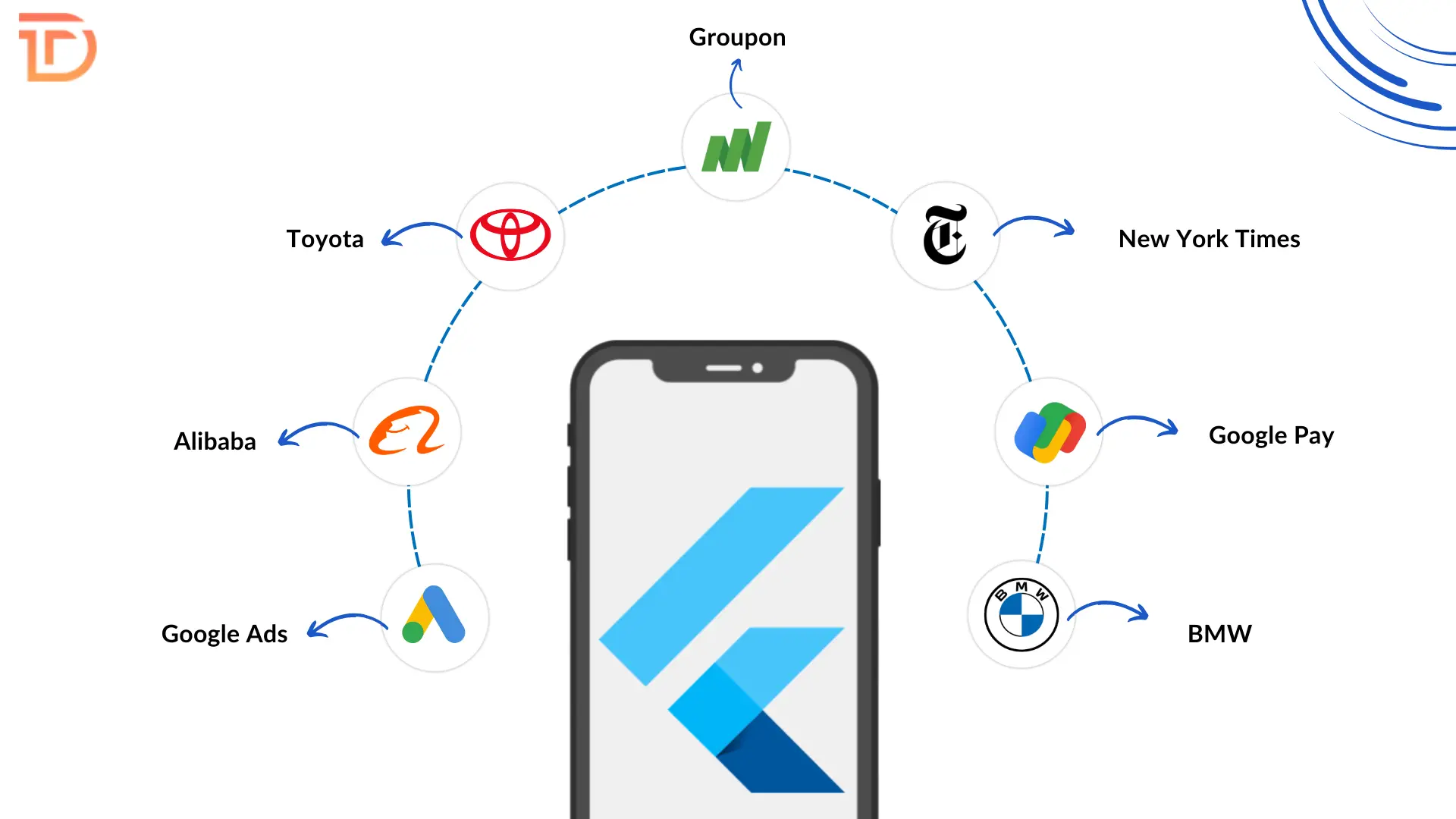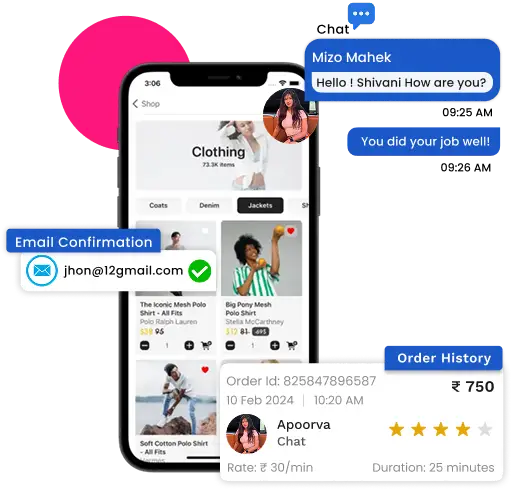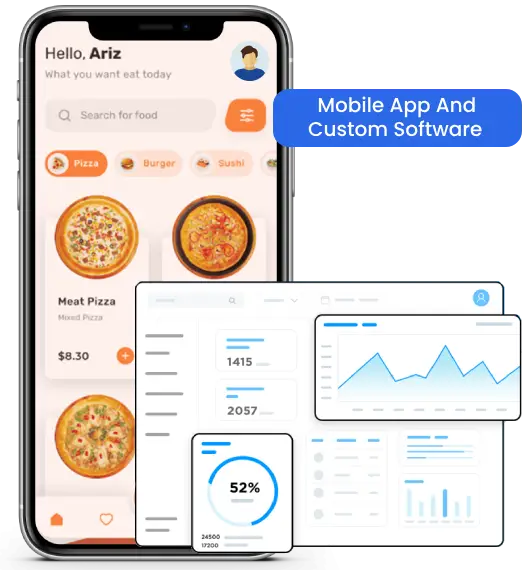Mobile applications have become an essential part of business growth, as users expect fast, seamless, and visually engaging experiences across devices. Companies face the challenge of delivering apps that meet current demands while remaining scalable for future growth. Flutter, developed by Google, provides a powerful solution for cross-platform mobile app development, allowing businesses to create high-performance applications for both iOS and Android using a single codebase. It’s hot-reload feature, rich widget library, and near-native performance help developers build visually appealing and responsive apps quickly. Flutter reduces development costs, simplifies maintenance, and supports rapid prototyping, making it an ideal choice for businesses seeking efficient, scalable, and future-ready mobile solutions. In this blog, we will explore why Flutter mobile app development is gaining popularity, examine key market statistics of Flutter, showcase real-life examples of apps created with Flutter, discuss how various industries leverage its capabilities, and explain why Flutter is a smart choice for your business.
Why Flutter Mobile App Development is Gaining Popularity
Flutter has experienced rapid adoption among developers and businesses worldwide due to several compelling advantages. Its ability to create cross-platform applications using a single codebase significantly reduces development time and resources. Companies can target both iOS and Android users without duplicating efforts, making it ideal for businesses with tight budgets or tight timelines. The framework supports expressive UIs and offers a rich set of pre-designed widgets that allow for consistent design across devices.
Performance is another key factor driving Flutter’s popularity. Applications built with Flutter compile directly to native code, ensuring smooth animations, fast load times, and minimal lag. Developers can leverage hardware acceleration for graphics-intensive applications and deliver near-native experiences. Flutter’s growing ecosystem, including packages, plugins, and community support, enables rapid development of complex features without building everything from scratch.
Companies increasingly recognize Flutter’s cost-effectiveness and scalability. The ability to maintain a single codebase reduces long-term maintenance costs and simplifies updates. Businesses can release updates simultaneously on multiple platforms, ensuring consistent user experiences and faster time-to-market. Flutter also supports integration with popular backend services, APIs, and third-party tools, making it suitable for a wide range of application types, from simple informational apps to complex enterprise solutions.
Market Stats of Flutter
The global demand for mobile app development has surged significantly over the past few years. According to a report by Statista, the average working hours of software developers globally continue to increase as companies invest in new applications and technology innovations. Flutter has emerged as one of the fastest-growing mobile app frameworks, with approximately 46 percent of global software developers utilizing it for cross-platform mobile development. About one-third of mobile developers employ cross-platform frameworks like Flutter, while the remainder rely on native development tools. In 2022, the global developer community reached 26.4 million, with this number expected to grow due to increasing demand for mobile and web development.
Analysts predict that the number of Flutter-based applications will continue to rise steadily, reflecting the increasing confidence of businesses in its scalability and performance. Companies ranging from startups to large enterprises are prioritizing cross-platform development solutions to reduce costs and accelerate product launches. Surveys indicate that over 40 percent of developers working on mobile projects in 2025 will choose Flutter or similar frameworks for their cross-platform capabilities. The strong community support, backed by Google’s continuous improvements, further solidifies Flutter’s position in the mobile app development landscape.
Flutter Mobile App Development is a Smart Choice: Here’s Why
Flutter is a powerful cross-platform framework that enables businesses to build high-performance mobile apps efficiently, and the following are the key reasons why it is a smart choice for your business:
- Single Codebase for Multiple Platforms – Flutter allows businesses to maintain one codebase for both iOS and Android. This reduces development and maintenance costs, eliminates the need for separate teams, streamlines operations, and accelerates deployment timelines, enabling companies to focus on product innovation and faster time-to-market.
- Near-Native Performance and UX – Applications built with Flutter deliver smooth animations, rapid load times, and responsive design. Its widget-based architecture enables highly customizable interfaces that align with brand aesthetics. Businesses can create apps that meet modern user expectations, enhancing engagement, retention, and overall satisfaction across platforms.
- Scalability and Long-Term Growth – Flutter supports applications that evolve with business needs, accommodating new features, growing user bases, and advanced functionalities without major code rewrites. Integration with cloud platforms, APIs, and backend services ensures seamless scaling, allowing companies to plan long-term growth without technology constraints or performance concerns.
- Rapid Prototyping and Iterative Development – Flutter enables quick testing of new features using hot reload. Teams can gather user feedback, refine functionalities, and adopt agile practices efficiently. Startups and enterprises benefit from faster market launches, reduced turnaround times, and the ability to pivot strategies based on real-time insights while controlling budgets.
- Enhanced Security Features – Flutter supports secure application development with encryption protocols, authentication systems, and privacy best practices. Sectors handling sensitive data, such as finance, healthcare, and education, can deploy apps confidently, maintaining compliance, protecting user information, and ensuring security without sacrificing performance or user experience.
- Simplified Maintenance and Updates – Developers can update Flutter apps simultaneously across platforms. A single, organized codebase ensures consistent user experiences, rapid bug fixes, and reduced operational overhead. Businesses can maintain high-quality apps without excessive maintenance costs, focusing resources on growth strategies and enhancing brand credibility over time.
- Cost-Effective Innovation – Flutter helps companies innovate faster while controlling expenses. Its cross-platform approach reduces staffing requirements and development hours. Rapid prototyping, reusable components, and smooth scalability allow businesses to experiment with new features, enhance customer engagement, and achieve strategic objectives without incurring prohibitive costs.
Overall, Flutter empowers businesses to deliver high-quality, scalable, and visually appealing applications that meet evolving market demands. Companies gain flexibility, efficiency, and a faster return on investment, making it an ideal choice for modern mobile app development initiatives.
Real Life Examples of Apps Created with Flutter
Several high-profile applications have leveraged Flutter’s capabilities to deliver consistent, high-performance user experiences across platforms. Following are the seven notable examples:

- Google Ads: Google Ads allows marketers to manage campaigns, monitor ad performance, and adjust budgets effortlessly. Flutter ensures a smooth, responsive interface across both Android and iOS devices, enabling real-time tracking, notifications, and analytics. The app’s consistent design and performance help users stay productive and make informed decisions while managing complex advertising campaigns.
- Alibaba: Alibaba uses Flutter for its Xianyu app, offering a seamless e-commerce experience. Users enjoy smooth navigation, animated transitions, and dynamic content updates, all optimized for mobile devices. Flutter’s cross-platform capabilities allow Alibaba to maintain a consistent look and feel while efficiently managing feature updates and ensuring high-speed performance for millions of active users.
- Toyota: Toyota leverages Flutter in its mobile applications to provide car owners with intuitive features such as service scheduling, vehicle monitoring, and real-time updates. The framework supports visually engaging interfaces and interactive elements while ensuring performance consistency across Android and iOS. Flutter enables Toyota to deliver a reliable, user-friendly experience for customers worldwide.
- Groupon: Groupon’s mobile app uses Flutter to display deals, track orders, and offer notifications efficiently. The framework allows the app to maintain fast loading times and responsive interactions while supporting attractive visuals and animations. Users benefit from smooth browsing, easy deal redemption, and a unified experience across multiple devices, enhancing engagement and satisfaction.
- New York Times: The New York Times app employs Flutter for news delivery, multimedia content, and personalized reading experiences. Flutter allows seamless scrolling, interactive articles, and live updates without compromising performance. Readers enjoy smooth navigation, high-quality visuals, and reliable notifications across both platforms, helping the app maintain high user retention and engagement rates worldwide.
- Google Pay: Google Pay uses Flutter to deliver secure, fast, and intuitive financial transactions on mobile devices. The framework supports smooth animations, instant notifications, and responsive layouts while ensuring consistent functionality across Android and iOS. Users can send money, pay bills, and manage accounts efficiently, enjoying a seamless experience that enhances trust and usability.
- BMW: BMW’s mobile app integrates Flutter to manage vehicle data, control car functions, and provide real-time updates. Flutter ensures visually appealing interfaces, smooth animations, and interactive elements while supporting high performance across multiple devices. Car owners benefit from an engaging, consistent experience that combines practicality, security, and necessary features for everyday mobility needs.
These applications demonstrate Flutter’s versatility in delivering complex functionalities while maintaining high user engagement and performance standards. Businesses can replicate these benefits for their own digital products, offering users intuitive and visually appealing experiences that adapt to evolving needs.
How is Flutter Leveraged by Various Industries
Flutter has become a popular choice across multiple sectors due to its flexibility, cost-effectiveness, and scalability. Industries that benefit from Flutter are:

- E-commerce: Flutter enables dynamic product catalogs, smooth animations, and responsive designs. Retailers can launch campaigns quickly, maintain consistent branding across platforms, and offer a seamless shopping experience for users on both Android and iOS devices.
- Healthcare: Mobile apps built with Flutter manage appointments, patient records, and telehealth consultations efficiently. Cross-platform compatibility ensures patients can access services on iOS and Android devices, while maintaining secure and reliable handling of sensitive medical data.
- Education Technology: Learning apps leverage Flutter to integrate interactive content, quizzes, and progress tracking. Developers avoid duplicating efforts across platforms, delivering smooth and engaging educational experiences that enhance student learning and teacher management.
- Finance and Banking: Flutter allows secure mobile banking apps with real-time analytics, transaction monitoring, and interactive dashboards. Fintech startups benefit from faster development, lower costs, and strong security measures while maintaining a consistent user experience.
- Media and Entertainment: Streaming apps, news platforms, and social engagement tools use Flutter to handle high-quality media content, complex animations, and responsive interfaces. Users enjoy smooth playback and visually engaging experiences across devices.
- Travel and Hospitality: Booking and itinerary apps built with Flutter provide personalized travel recommendations and seamless experiences across devices. Cross-platform development ensures consistency, usability, and customer satisfaction while minimizing development efforts.
- Logistics: Flutter apps integrate with backend tracking systems, enabling real-time shipment updates and navigation. Users benefit from smooth interfaces, reliable performance, and interactive features that support operational efficiency and customer engagement across devices.
The Way Forward
Flutter mobile app development offers a strategic advantage for businesses seeking scalable, cost-effective, and high-performance solutions. Its cross-platform capabilities, expressive UI design, fast deployment, and maintainable code structure align perfectly with modern custom mobile application development goals. Companies adopting Flutter gain an edge in user engagement, development efficiency, and long-term application scalability while streamlining their product strategy across platforms.
Dreamer Technoland specializes in custom flutter mobile app development, helping businesses build high-quality applications packed with features. We provide end-to-end support, from concept design to deployment, ensuring apps are scalable, secure, and optimized for performance. Our expertise includes cross-platform development, UI/UX design, API integration, and ongoing maintenance. Companies and individuals partnering with us can leverage our experience to accelerate development, reduce costs, and create applications that deliver measurable business impact.







